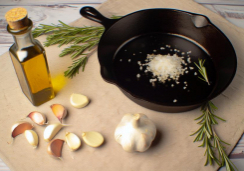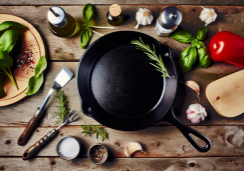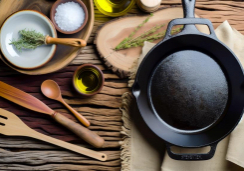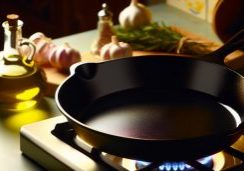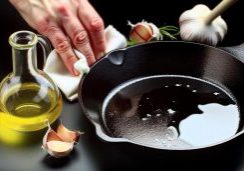How to Season Your Cast Iron Skillet Perfectly
Seasoning your cast iron skillet is akin to laying a foundation for a culinary masterpiece: it's an essential first step that ensures longevity and non-stick bliss. You've likely heard the buzz about these kitchen stalwarts, but you may not know the secrets to achieving that coveted, slick patina.
It's about more than just slathering on oil and baking; a precise alchemy balances the type of oil, the temperature, and the timing. As you stand armed with your skillet, eager to unlock its potential, remember that the perfect seasoning is within reach.
Let's walk through how you can create a non-stick surface that rivals the best, and explore why this age-old technique can transform your cooking experience.
Initial Cleaning Process
Before you start crafting delicious meals with your new cast iron skillet, you'll need to wash it with warm, soapy water to strip away any factory residue. This initial cleaning process is crucial to prepare your pan for the delicious journey ahead.
Go ahead and use soap this one time—contrary to popular belief, it won't harm your skillet. Just make sure you've got a stiff brush or sponge to thoroughly scrub the surface. If you encounter any stubborn spots, kosher salt can be your abrasive ally, helping to scour away any lingering bits without damaging the iron. Once the pan is clean, it's imperative to dry it completely. Lingering moisture is the adversary of cast iron, so don't shy away from using heat to banish every last drop of water.
Now, you're set to start the seasoning cast. Coat your skillet inside and out with a thin layer of cooking oil—vegetable or canola oil are great choices. Avoid using too much oil; a heavy hand can lead to sticky spots. Buff it well until the skillet feels smooth, not greasy. Lastly, bake the oiled pan in a 450°F oven for 30 minutes. This step initiates a bond between oil and iron, creating a non-stick surface that will make future cooking a dream.
Apply Oil Evenly
To achieve a perfectly seasoned cast iron skillet, start by applying a thin layer of oil across the entire pan, using a paper towel to ensure it's evenly distributed without leaving it greasy. This crucial step in the seasoning process creates a protective layer that not only enhances your skillet's performance but also contributes to its longevity.
Select a high-smoke point oil, like vegetable oil, and drizzle just enough to coat the cast iron pan's surface. With the paper towel in hand, gently rub the oil over every inch, including the exterior, bottom, sides, and handle. The goal is to apply oil evenly, creating a surface that food won't stick to. It's tempting to use too much oil, but resist; excess can lead to a sticky finish after the layer of oil baked on.
Once you've achieved an even coating, check for any pooling or excess oil. If it looks greasy, you've gone too far. Reapply oil and continue the rubbing process until the skillet absorbs the oil and appears matte, not shiny. This attention to detail pays off, resulting in a delightfully non-stick, rust-resistant cast iron skillet, ready to cook up culinary masterpieces.
Bake in the Oven
Heat your oven to 400°F and prepare to transform your skillet into a non-stick culinary canvas with a simple baking process that seals in the seasoning. After you've applied a thin coat of high smoke point oil, like flaxseed oil, to your cast iron pan, it's time to bake in the oven. The oil's role is crucial here—it's not just a protective coat but a building block for your pan's future.
Place your skillet upside down on the middle rack to ensure an even bake. This position prevents oil from pooling and creating an uneven layer of seasoning. Let the heat work its magic for an hour, a period that initiates polymerization—the process where oil transforms into a hardened, slick surface that makes your pan non-stick and ready for countless meals.
Once the hour is up, turn off the oven and let your cast iron pan cool down slowly inside, undisturbed. This gradual cooling is essential for the layer of seasoning to set properly. If you're aiming for an exceptionally resilient surface, you might want to repeat this process a few times. Each layer you add fortifies your skillet, enhancing its performance and longevity.
With patience and care, your cast iron will be primed for culinary success.
Repeat Seasoning Steps
Layering your cast iron skillet with additional seasoning sessions will enhance its non-stick properties and overall durability, ensuring that every meal you cook is both effortless and exquisite. The process is simple: after the initial seasoning, you'll want to repeat the oiling and heating steps three to four times. This builds up a robust initial layer of seasoning. Think of it as reinforcing the protective coating that makes your cast-iron skillet a culinary champion.
As you engage in this repeat seasoning process, remember that the key to success lies in the polymerization of the oil or fat you use. When exposed to high heat, the oil transforms into a hardened, slick surface that's integral to the layers of seasoning. This transformation not only contributes to that coveted non-stick surface but also guards against rust and wear.
Once you've completed the repeat seasoning steps, let the pan cool down completely before you put it to the test. And remember, regular use is the best way to maintain the skillet's seasoning. Each time you cook with fat, you're essentially adding more layers of seasoning. So, cook often, and rest assured that a well-seasoned pan can handle even acidic foods without a fuss.
Is There a Specific Technique for Perfectly Seasoning a Cast Iron Skillet?
When it comes to seasoning a cast iron skillet, the key is to use a thin layer of oil and bake it in the oven at a high temperature. This will create a natural non-stick surface that will improve with each use. Properly seasoning a cast iron skillet is essential for maintaining its durability and preventing rust.
Ongoing Maintenance Tips
While building up a solid initial seasoning is crucial for your cast iron skillet's performance, it's equally important to keep up with regular maintenance to preserve its non-stick qualities and prevent damage.
Every time you cook, you're contributing to your well-seasoned cast iron's patina, but there are a few ongoing maintenance tips to ensure it remains in tip-top shape.
Firstly, always use your cast iron cookware with a bit of oil; the best oil is one that can withstand high heat and contribute to the process called polymerization. This reaction creates a layer of carbonized protection that adds to the seasoning. After cooking, let the pan cool slightly, then carefully remove any leftover food bits while it's still warm. Avoid soaking it in water, as this can lead to rust.
Lastly, give your cast iron a quick rinse, dry it thoroughly, and apply a small amount of oil before storing it. This routine won't only keep your cast iron performing beautifully but will also deepen the flavor profiles in your culinary creations.
Conclusion
Now that you've masterfully seasoned your cast iron skillet, it's ready to deliver delicious, non-stick meals.
Remember to gently clean it after each use, keeping that smooth, savory surface intact.
With every sizzle and sear, your skillet's character deepens—just like the flavors it imparts.
Keep up the simple care routine, and your trusty skillet won't just cook your food; it'll enhance every bite.
Here's to a lifetime of hearty, mouthwatering dishes from your perfectly seasoned companion!

